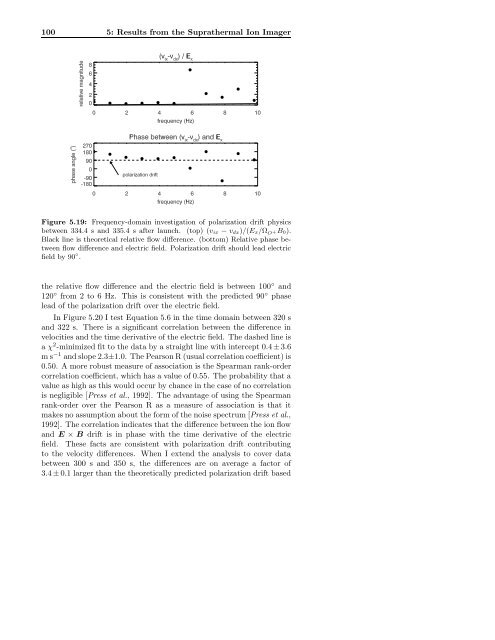PhD thesis - Institute for Space Research - University of Calgary
PhD thesis - Institute for Space Research - University of Calgary
PhD thesis - Institute for Space Research - University of Calgary
Create successful ePaper yourself
Turn your PDF publications into a flip-book with our unique Google optimized e-Paper software.
100 5: Results from the Suprathermal Ion Imager<br />
Figure 5.19: Frequency-domain investigation <strong>of</strong> polarization drift physics<br />
between 334.4 s and 335.4 s after launch. (top) (v ix − v dx )/(E x/Ω O +B 0).<br />
Black line is theoretical relative flow difference. (bottom) Relative phase between<br />
flow difference and electric field. Polarization drift should lead electric<br />
field by 90 ◦ .<br />
the relative flow difference and the electric field is between 100 ◦ and<br />
120 ◦ from 2 to 6 Hz. This is consistent with the predicted 90 ◦ phase<br />
lead <strong>of</strong> the polarization drift over the electric field.<br />
In Figure 5.20 I test Equation 5.6 in the time domain between 320 s<br />
and 322 s. There is a significant correlation between the difference in<br />
velocities and the time derivative <strong>of</strong> the electric field. The dashed line is<br />
a χ 2 -minimized fit to the data by a straight line with intercept 0.4 ± 3.6<br />
m s −1 and slope 2.3±1.0. The Pearson R (usual correlation coefficient) is<br />
0.50. A more robust measure <strong>of</strong> association is the Spearman rank-order<br />
correlation coefficient, which has a value <strong>of</strong> 0.55. The probability that a<br />
value as high as this would occur by chance in the case <strong>of</strong> no correlation<br />
is negligible [Press et al., 1992]. The advantage <strong>of</strong> using the Spearman<br />
rank-order over the Pearson R as a measure <strong>of</strong> association is that it<br />
makes no assumption about the <strong>for</strong>m <strong>of</strong> the noise spectrum [Press et al.,<br />
1992]. The correlation indicates that the difference between the ion flow<br />
and E × B drift is in phase with the time derivative <strong>of</strong> the electric<br />
field. These facts are consistent with polarization drift contributing<br />
to the velocity differences. When I extend the analysis to cover data<br />
between 300 s and 350 s, the differences are on average a factor <strong>of</strong><br />
3.4 ± 0.1 larger than the theoretically predicted polarization drift based


